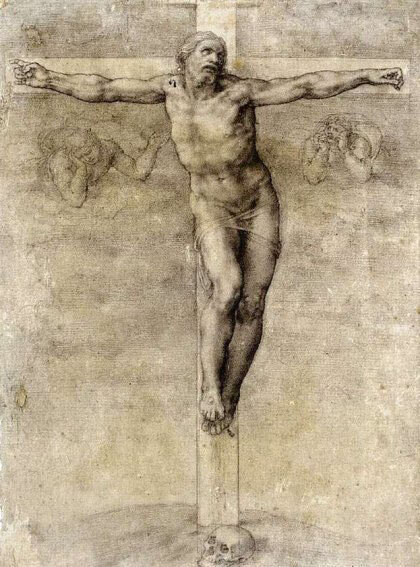Michelangelo’s Use of Drawing
Many of us feel that our paintings should effortlessly flow out from our heads, through our hands, landing perfectly on canvas, This is something that even Michelangelo wouldn’t be able to pull off. When the opportunity presents itself to embark on a painting project deserving of higher standards, use drawing and preparatory sketches to work out your ideas.
Only 600 of Michelangelo’s drawings survive, and we know that he ordered many more of them to be burned. Perhaps it was to maintain his reputation as the “Divine One”, by hiding the tremendous effort, work, and planning his creations required. Drawings are the proof of our mortal humanity. Fiercely competitive, he may have been paranoid about others, like Raphael, plagiarizing and stealing his secrets. This alone suggests just how much information can be worked out in a drawing that is later hidden within a painting.
Studies of the Crucified Christ 1534-36, Black chalk
Probably drawn from a live model, this study depicts Christ’s heavy body hanging from an invisible Y- shaped cross.
Michelangelo would have close-up studies scattered within his drawings, zeroing in on various angles and positions for complex forms, joints, twists, and tensions, exploring the gestural rhythms holding his monumental figures together. Every pose was seen in his mind and worked out by hand, often meticulously descriptive. These studies contributed to the palpable sense of movement and fullness in every work he completed. Notice the voluminous shapes and idealized forms, the expressiveness born of his deep religious feeling.
To Michelangelo, who viewed sculpture as the supreme art, drawing was merely a tool for working out his ideas. He used them to isolate individual figures within groups, altering or rejecting his ideas as the final design took shape. In a fresco, there isn’t enough time to reconfigure or reposition; painting into wet plaster as it dries leaves no room for error. Drawing was also considered the most important way of learning, as he instructed his student in a note, “Draw Antonio, draw Antonio, draw and don't waste time.”
We should all draw from life, as Michelangelo did, to get a better sense of our subjects from every angle. He brought a level of knowledge, curiosity, and love that swells his drawings, frescoes, architecture, and sculpture. Michelangelo’s work expresses the Platonic belief that the essence of the supernatural and divine can be reached by creating perfect physical beauty, which he helps us discover through the male form. Follow your passions and be true to your beliefs as they change, and they will be recorded in the art you make.
Vasari commented on this drawing of Christ: “One sees the body not abandoned to fall like dead, but as if living, through bitter suffering arousing itself and writhing.”

